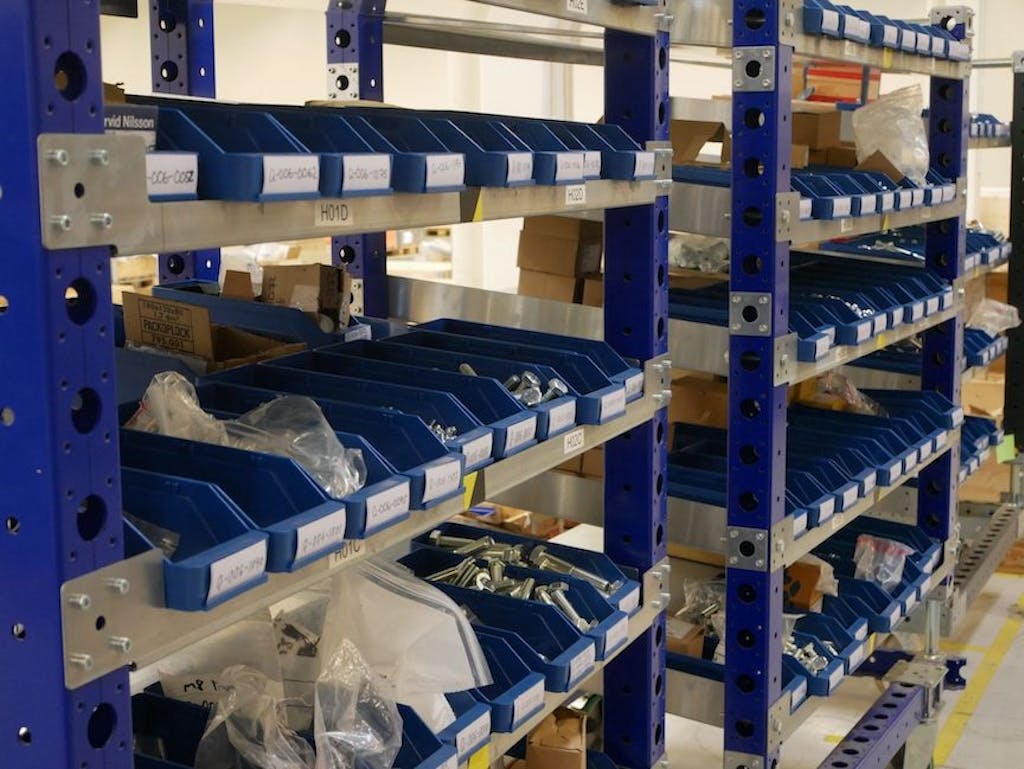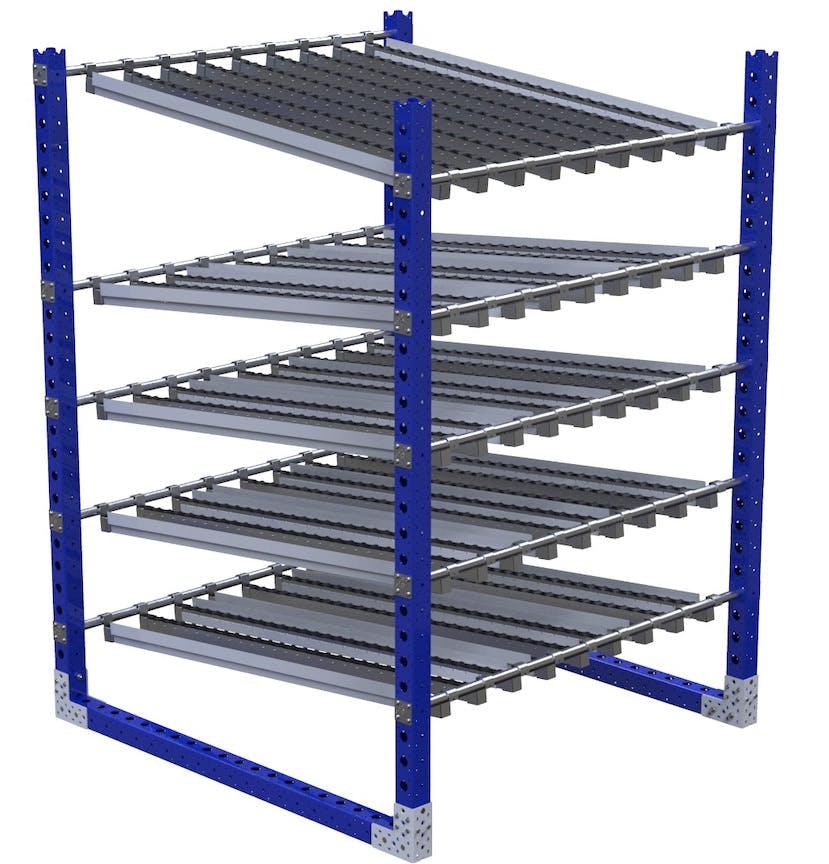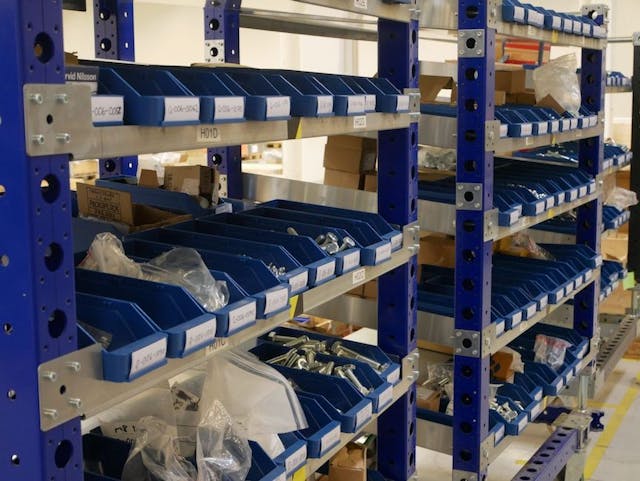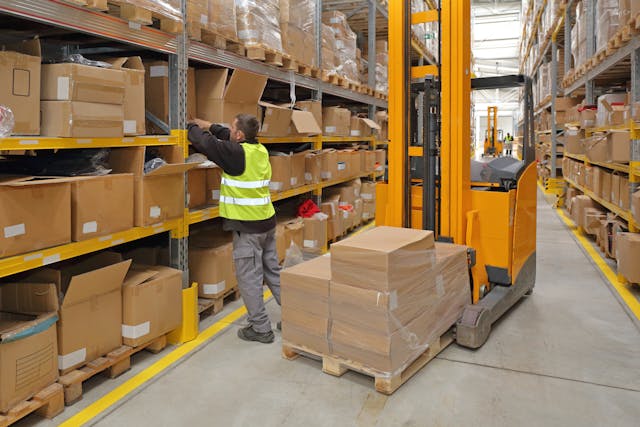The Ins and Outs of Flow Racks

Flow racks have been commonly used within manufacturing facilities for a long time and have become one of the most common types of material handling equipment used.
Manufacturing facilities use a combination of material handling equipment to ensure a smooth and efficient process. The types of material handling equipment include:
- Material handling carts
- Racks
- Forklifts
- Flow Racks
- Conveyors
- Cranes
Using a combination of all of these forms of material handling equipment leads to a complicated process of goods and parts moving throughout a facility. Flow racks play an important role in this, especially within manufacturing facilities as they help to present parts to operators in an ergonomic fashion.
So what is a flow rack?
A flow rack is a racking system that have angled shelves to use gravity to pull boxes, containers, or totes from one side to the other. Generally, the containers or boxes are placed in one side of the flow rack or “fed” into the rack and then they are presented to the operators on the other side. Essentially they provide a flow between the input side and the output side of the rack.
Flow racks can also be referred to as gravity racks, feed racks, or flow chutes. At FlexQube we use two different types of shelves in our flow racks, the first being a roller shelf which is most common in these forms of racks. The second being a solid steel flat shelf that is angled so the force of gravity still creates the flow of goods. So which should you use when designing your roller rack?
Roller Shelves
The roller shelves that we most commonly used are shelves that are made up of a selection of single roller rails. Each roller rail is a collection of rollers lined up in a line and secured together to create a line of rollers. Depending on how wide you need the shelf to be, and what products you are placing on the shelves would depend on how many roller rails you need to create your roller rail. See the image below to see the difference in shelf widths and the number of roller rails needed.

Angled Flat Shelves
The other type of shelf we commonly use at FlexQube is a powder-coated steel flat shelf which is installed on our carts at an angle to get the flow function. The benefit of using these types of shelves over the roller shelves is the robustness of the shelf. If you will be placing heavier materials onto the flow shelves than these solid steel shelves are able to withstand a higher total weight when compared to the roller rails.
Where would these flow racks be used?
When it comes to manufacturing flow racks are used in many places throughout facilities. However, most commonly they are used close to where human operators are working and doing some form of work. What we mean by work can be broad, because these racks can be used in a picking area where operators are picking products to be placed into a kit that will be delivered to the assembly line. Or, these racks can be placed at the assembly line for operators to have ergonomic access to the materials and pick directly for assembly along the line.
Larger flow racks can almost work as large conveyors where operators don’t have to carry materials over short distances. For example, receiving goods at one point and instead of having to manually walk the materials down to the next station. A large flow rack with a slight angle can be used so the operators can walk alongside the materials to the next station. Think similar to an airport security conveyor where you walk goods along with the roller racks prior to going through the metal detector. This is a much similar concept within a manufacturing facility and it greatly improves the ergonomics for the operators working within the facility.
Why should you use flow racks in your manufacturing facility?
The first reason for using flow racks within your facility is because they encourage better ergonomics. Empty containers can be removed from each rack when they are finished and because of gravity, they will automatically be replaced by a full container waiting behind. Using, this type of system always keeps full materials at the front of the rack in the picking area for the operators. This greatly reduces the need for operators to reach and stretch for new materials, drastically improving ergonomics.
The next main reason for using flow racks is because it encourages FIFO (First in, First out) which can be seen as an inventory control method. It is quite straight forward but it means the first materials places on the flow rack will be the first materials taken by operators from the flow rack. This ensures the older materials or stock on the flow racks will be ensured to be used first and as you continue to replenish the flow rack the older goods to be on the rack will be first up to be used by the operator.
The final benefit of using flow racks is that it can help visually organize your containers and boxes as well as providing efficient storage. So when flow racks are implemented along the assembly line it can be used as a visual organization tool, color coding different containers and shelves so the operators know exactly where to pick every time.
Industries Flow Racks are Commonly used
Automotive
Flow racks are very commonly used within the manufacturing facilities of automotive suppliers and OEM’s. They are used because of their flexibility and adaptability to match different parts and their sizes.
Distribution
Flow racks are also very common within distribution centers because of the ability to help with the organization of products and goods. The racks can make it very easy for the order pickers to pick the products in an ergonomic and efficient manner.
E-Commerce
Like distribution flow racks are widely used within e-commerce warehouses because of their ability to organize and store a large number of goods. Making it easier for the warehouse operators to pick the orders as they come, and having stock being replenished in a FIFO manner.
Industrial Equipment
Similar to automotive flow racks are commonly used within the manufacture of industrial equipment because of their flexibility for different parts. On top of this, the improvements in ergonomics for the operators along the assembly line are also seen as a big benefit.
At FlexQube we are able to custom design any size of flow racks that you may be looking for depending on what materials you need to hold and the goals you want to achieve. Feel free to browse through our selection of flow solutions here.





